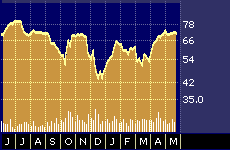
What’s Next for Microsoft?
What’s Next for Microsoft?
By Hal Plotkin
CNBC.com Silicon Valley Correspondent
May 30, 2001 03:36 PM

Microsoft Corp. 52-week stock performance
Microsoft Corp.’s {MSFT, News, Boards} stock has moved up nicely in recent weeks as investors anticipate the launch of new products and fears recede that the company will be broken up as a result of the pending federal anti-trust case.
The recent uptick in price, however, has at least some analysts warning that Microsoft’s stock now appears to be near the top of its trading range. For longer-term investors, though, the bigger issue is whether Microsoft’s best days are ahead or behind the world’s leading software firm.
The question has some of Silicon Valley’s top high-tech industry analysts sharply divided.
“There is no company positioned quite like Microsoft,” says Rob Enderle, vice president of the Giga Information Group, based in San Jose. “But clearly, it’s an aging giant. I think we’re going to see the company curtailed significantly over the next five years.”
Enderle notes that law enforcement officials in several states have recently confirmed their intentions to take the anti-trust case against Microsoft to the U.S. Supreme Court should the company prevail in its current appeal, which would keep the case in motion even if the Bush administration decides to back off. He also says the company is facing similar questions about its business practices in Europe. As such, Enderle thinks it unlikely there will be a swift and final resolution of the legal and organizational issues swirling around the firm.
What’s more, Enderle agrees with several other analysts who say they don’t expect to see the company benefit significantly over the short term from its highly-touted series of new product rollouts, which include a new version of its PC operating system, called Windows XP, the Xbox video game console, Office XP, and its recently introduced UltimateTV digital television recorder.
CNBC.com: Can XP Invigorate Microsoft?
“Microsoft’s execution is suffering,” he says. “Windows 2000 and Windows ME didn’t do particularly well and Windows XP is not what most business users were hoping for. Xbox does have a lot of potential and will be trendy this year, but by next year it’s going to look old. Basically, the company is living off the past, but having much more trouble moving into the future.”
Enderle says he has little doubt that Microsoft will be less central to the technology universe in five to 10 years time given the advent of other increasingly popular platforms for mobile devices, digital entertainment, and computer servers, such as the Palm and Linux operating systems.
Tim Bajarin, a veteran industry analyst at Creative Strategies Inc., based in Campbell, Calif., sharply disagrees.
“I strongly believe that Microsoft’s best days are ahead,” he says. “Decktop PCs are not going to go away. They’re going to continue to play a major role in what Steve Jobs calls the ‘digital lifestyle.”
Bajarin adds the Microsoft does not have to dominate the new markets it’s now entering in order for the company to be considerably larger and more profitable five to 10 years out.
“People have to understand that Microsoft is not a one-trick pony anymore,” he says. “Even if Microsoft ends up with only 25 to 30 percent [market share] of the new platforms, they will still be a bigger company than they are today.”
Bajarin says that many people take Microsoft’s successes for granted and underestimate the role those successes will play in helping the company further extend its growth.
“The fact that my PC and files are all compatible is a very big positive,” he says. “Who out there is in a better position to integrate different technologies?”
Bajarin says the technology and investment landscape is littered with the corpses of those who have underestimated Microsoft. In fact, he says it’s virtually impossible to meaningfully compare the company to any of its would-be competitors.
“I don’t see anybody who comes close to Microsoft when it comes to clout and the ability to extend their reach,” he says.
Some analysts are warning, however, that there might not be much more upside left for Microsoft’s stock over the short-term until macro-economic conditions brighten or the firm’s new products begin to show some traction in the marketplace.
“We continue to believe that the hype surrounding Windows XP, Office XP, and Xbox will be greater than the actual impact on financial performance,” Merrill Lynch analyst Henry Blodget wrote in a recent research note. “But,” he adds, “hype often helps stocks.”
Blodget notes that at 71 a share the stock is trading at 35 times his calendar year earnings per share estimate of $2.00.
“We view this as a high multiple relative to the growth rate, but we believe near-term catalysts could cause additional multiple expansion.”
Institutional buyers placed some large bets on Microsoft’s stock last quarter as they stepped in to scoop the stock up off its 52-week low of 42 a share. Net purchases by mutual funds, hedge funds, and other institutional traders totaled 126 million shares, or $6.9 billion, for the quarter ended March 31.
The buying of Microsoft’s stock was led by Putnam Investment Management, which purchased 28.2 million shares, Fidelity Management & Research, which purchased 23.1 million shares, American Century Investment Management, which purchased 10.75 million shares and Alliance Capital Management, which purchased 7 million shares, according to the Securities and Exchange Commission.
Microsoft’s Office XP is currently slated to launch on May 31, with Windows XP and the Xbox game console set to make their formal debuts in October and November, respectively.


